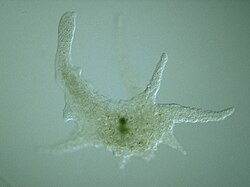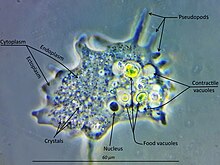Amoebozoa
| Amoebozoa Temporal range:
| |
|---|---|

| |
Chaos carolinensis
| |
| Scientific classification | |
| Domain: | Eukaryota |
| Clade: | Amorphea |
| Phylum: | Amoebozoa Lühe, 1913 emend. Cavalier-Smith, 1998[3] |
| Clades[4][5] | |
| Synonyms | |
| |
Amoebozoa is a major
Amoebozoa includes many of the best-known amoeboid organisms, such as
While the majority of amoebozoan species are unicellular, the group also includes several clades of
Amoebozoa vary greatly in size. Some are only 10–20 μm in diameter, while others are among the largest protozoa. The well-known species Amoeba proteus, which may reach 800 μm in length, is often studied in schools and laboratories as a representative cell or model organism, partly because of its convenient size. Multinucleate amoebae like Chaos and Pelomyxa may be several millimetres in length, and some multicellular amoebozoa, such as the "dog vomit" slime mold Fuligo septica, can cover an area of several square meters.[13]
Morphology

Amoebozoa is a large and diverse group, but certain features are common to many of its members. The amoebozoan cell is typically divided into a granular central mass, called endoplasm, and a clear outer layer, called ectoplasm. During locomotion, the endoplasm flows forwards and the ectoplasm runs backwards along the outside of the cell. In motion, many amoebozoans have a clearly defined anterior and posterior and may assume a "monopodial" form, with the entire cell functioning as a single pseudopod. Large pseudopods may produce numerous clear projections called subpseudopodia (or determinate pseudopodia), which are extended to a certain length and then retracted, either for the purpose of locomotion or food intake. A cell may also form multiple indeterminate pseudopodia, through which the entire contents of the cell flow in the direction of locomotion. These are more or less tubular and are mostly filled with granular endoplasm. The cell mass flows into a leading pseudopod, and the others ultimately retract, unless the organism changes direction.[14]
While most amoebozoans are "naked," like the familiar Amoeba and Chaos, or covered with a loose coat of minute scales, like Cochliopodium and Korotnevella, members of the order Arcellinida form rigid shells, or tests, equipped with a single aperture through which the pseudopods emerge. Arcellinid tests may be secreted from organic materials, as in Arcella, or built up from collected particles cemented together, as in Difflugia.
In all amoebozoa, the primary mode of nutrition is phagocytosis, in which the cell surrounds potential food particles with its pseudopods, sealing them into vacuoles within which they may be digested and absorbed. Some amoebozoans have a posterior bulb called a uroid, which may serve to accumulate waste, periodically detaching from the rest of the cell.[citation needed] When food is scarce, most species can form cysts, which may be carried aerially and introduce them to new environments.[citation needed] In slime moulds, these structures are called spores, and form on stalked structures called fruiting bodies or sporangia. Mixotrophic species living in a symbiotic relationship with microalgae of the genus Chlorella, which lives inside the cytoplasm of their host, have been found in Arcellinida and Mayorella.[15][16]
The majority of Amoebozoa lack flagella and more generally do not form microtubule-supported structures except during mitosis. However, flagella do occur among the Archamoebae, and many slime moulds produce biflagellate gametes [citation needed]. The flagellum is generally anchored by a cone of microtubules, suggesting a close relationship to the opisthokonts. [citation needed] The mitochondria in amoebozoan cells characteristically have branching tubular cristae. However, among the Archamoebae, which are adapted to anoxic or microaerophilic habitats, mitochondria have been lost.
Classification
Place of Amoebozoa in the eukaryote tree
It appears (based on molecular genetics) that the members of Amoebozoa form a sister group to animals and fungi, diverging from this lineage after it had split from the other groups,[17] as illustrated below in a simplified diagram:
Opimoda
|
|
Strong similarities between Amoebozoa and
Subphyla within Amoebozoa: Lobosa and Conosa
Traditionally all amoebozoa with lobose pseudopods were grouped together in the class
However, revised trees by Cavalier-Smith and Chao in 1996[19] suggested that the remaining lobosans do form a monophyletic group, to which the Archamoebae and Mycetozoa were closely related, although the percolozoans were not. Subsequently, they emended the phylum Amoebozoa to include both the subphylum Lobosa and a new subphylum Conosa, comprising the Archamoebae and the Mycetozoa.[3]
Recent molecular genetic data appear to support this primary division of the Amoebozoa into Lobosa and Conosa.[8] The former, as defined by Cavalier-Smith and his collaborators, consists largely of the classic Lobosea: non-flagellated amoebae with blunt, lobose pseudopods (Amoeba, Acanthamoeba, Arcella, Difflugia etc.). The latter is made up of both amoeboid and flagellated cells, characteristically with more pointed or slightly branching subpseudopodia (Archamoebae and the Mycetozoan slime molds).
Phylogeny and taxonomy within Amoebozoa
From older studies by Cavalier-Smith, Chao & Lewis 2016[20] and Silar 2016.[21] Also recent phylogeny indicates the Lobosa are paraphyletic: Conosa is sister of the Cutosea.[5][22][23]
| Amoebozoa phylogeny | ||||||||||||||||||||||||||||||||||||||||||||||||||||||||||||||||||||||||||||||||||||||||||||||||||||||||||||||||||||||||||||||||||||||||||||||||||||||||||||||||||||||||||||||||||||
|---|---|---|---|---|---|---|---|---|---|---|---|---|---|---|---|---|---|---|---|---|---|---|---|---|---|---|---|---|---|---|---|---|---|---|---|---|---|---|---|---|---|---|---|---|---|---|---|---|---|---|---|---|---|---|---|---|---|---|---|---|---|---|---|---|---|---|---|---|---|---|---|---|---|---|---|---|---|---|---|---|---|---|---|---|---|---|---|---|---|---|---|---|---|---|---|---|---|---|---|---|---|---|---|---|---|---|---|---|---|---|---|---|---|---|---|---|---|---|---|---|---|---|---|---|---|---|---|---|---|---|---|---|---|---|---|---|---|---|---|---|---|---|---|---|---|---|---|---|---|---|---|---|---|---|---|---|---|---|---|---|---|---|---|---|---|---|---|---|---|---|---|---|---|---|---|---|---|---|---|---|
|
Phylum Amoebozoa Lühe 1913 emend. Cavalier-Smith 1998 [Amoebobiota; Eumycetozoa Zopf 1884 emend Olive 1975]
- Clade Discosea Cavalier-Smith 2004 stat. nov. Adl et al. 2018
- Order ?Stereomyxida Grell 1971
- Order ?StygamoebidaSmirnov & Cavalier-Smith 2011
- Class CentramoebiaCavalier-Smith et al. 2016
- Order CentramoebidaRogerson & Patterson 2002 em. Cavalier-Smith 2004
- Order Himatismenida Page 1987 [Cochliopodiida]
- Order PellitidaPage 1987 [Cochliopodiida]
- Order
- Class Flabellinia Smirnov & Cavalier-Smith 2011 em. Kudryavtsev et al. 2014
- Order ThecamoebidaSchaeffer 1926 em. Smirnov & Cavalier-Smith 2011
- Order DermamoebidaCavalier-Smith 2004 em. Smirnov & Cavalier-Smith 2011
- Order VannellidaSmirnov et al. 2005
- Order Dactylopodida Smirnov et al. 2005
- Order
- Clade Tevosa Kang et al. 2017
- Clade Tubulinea Smirnov et al. 2005 stat. nov. Adl et al. 2018
- Class Corycidia Kang et al. 2017 stat. nov. Adl et al. 2018
- Order TrichosidaMoebius 1889
- Family Microcoryciidaede Saedeleer 1934
- Order
- Class Echinamoebia Cavalier-Smith 2016 stat. nov. Adl et al. 2018
- Order EchinamoebidaCavalier-Smith 2004 em. 2011
- Order
- Class Elardia Kang et al. 2017 stat. nov. Adl et al. 2018
- Subclass Leptomyxia Cavalier-Smith 2016
- Order Leptomyxida Pussard & Pons 1976 em. Page 1987
- Subclass EulobosiaCavalier-Smith 2016
- Order EuamoebidaLepşi 1960 em. Cavalier-Smith 2016
- Order Arcellinida Kent 1880
- Order
- Subclass Leptomyxia Cavalier-Smith 2016
- Class Corycidia Kang et al. 2017 stat. nov. Adl et al. 2018
- Clade Evosea Kang et al. 2017 stat. nov. Adl et al. 2018
- Clade CutosaCavalier-Smith 2016 stat. nov.
- Class Cutosea Cavalier-Smith 2016
- Order SquamocutidaCavalier-Smith 2016
- Order
- Class Cutosea Cavalier-Smith 2016
- Subphylum Conosa Cavalier-Smith 1998 stat. nov.
- Infraphylum Archamoebae Cavalier-Smith 1993 stat. n. 1998
- Class ArchamoebeaCavalier-Smith 1983 stat. n. 2004
- Family TricholimacidaeCavalier-Smith 2013
- Family EndamoebidaeCalkins 1926
- Order EntamoebidaCavalier-Smith 1993
- Order PelobiontidaPage 1976 emend. Cavalier Smith 1987
- Family
- Class
- Infraphylum SemiconosiaCavalier-Smith 2013
- Class VarioseaCavalier-Smith et al. 2004
- Order ?Flamellidae Cavalier-Smith 2016
- Order ?HolomastigidaLauterborn 1895 [Artodiscida Cavalier-Smith 2013]
- Order PhalansteriidaHibberd 1983
- Order Ramamoebida Cavalier-Smith 2016
- Order Profiliida Kang et al. 2017 [Protosteliida Olive & Stoianovitch 1966 em. Shadwick & Spiegel 2012]
- Order Fractovitellida Lahr et al. 2011 em. Kang et al. 2017
- Superclass Mycetozoa de Bary, 1859 ex Rostafinski, 1873
- Class DictyosteleaHawksworth et al. 1983
- Order Acytosteliales Baldauf, Sheikh & Thulin 2017
- Order DictyostelialesLister 1909 em. Olive 1970
- Class Ceratiomyxomycetes Hawksworth, Sutton & Ainsworth 1983
- Order ProtosporangiidaShadwick & Spiegel 2012
- Order CeratiomyxidaMartin 1961 ex Farr & Alexopoulos
- Order
- Class Myxomycetes Link 1833 em. Haeckel 1866 [24]
- Subclass Lucisporomycetidae Leontyev et al. 2019
- Superorder Cribrarianae Leontyev 2015
- Order Cribrariales Macbr. 1922
- Superorder Trichianae Leontyev 2015
- Order Reticulariales Leontyev 2015
- Order Liceales Jahn 1928
- Order Trichiales Macbride 1922
- Superorder Cribrarianae Leontyev 2015
- Subclass Columellomycetidae Leontyev et al. 2019
- Order ?Echinosteliopsidales Shchepin et al.
- Superorder Echinostelianae Leontyev 2015
- Order Echinosteliales Martin 1961
- Superorder Stemonitanae Leontyev 2015 [Fuscisporida Cavalier-Smith 2012]
- Order Clastodermatales Leontyev 2015
- Order Meridermatales Leontyev 2015
- Order StemonitalesMacbride 1922
- Order Physarales Macbride 1922
- Subclass Lucisporomycetidae Leontyev et al. 2019
- Class
- Class
- Infraphylum Archamoebae Cavalier-Smith 1993 stat. n. 1998
- Clade
- Clade Tubulinea Smirnov et al. 2005 stat. nov. Adl et al. 2018
Fossil record
Vase-shaped
List of amoebozoan protozoa pathogenic to humans
Meiosis
The recently available Acanthamoeba genome sequence revealed several orthologs of genes employed in meiosis of sexual eukaryotes. These genes included Spo11, Mre11, Rad50, Rad51, Rad52, Mnd1, Dmc1, Msh and Mlh.[26] This finding suggests that Acanthamoeba is capable of some form of meiosis and may be able to undergo sexual reproduction.
In sexually reproducing eukaryotes,
Studies of
Since Amoebozoa diverged early from the eukaryotic family tree, these results also suggest that meiosis was present early in eukaryotic evolution.
Human health
Invasion of the intestinal lining causes
Prevention of amoebiasis is by separating food and water from faeces and by proper
Amoebiasis is present all over the world.
Gallery
-
Arcella sp. test (Lobosa: Tubulinea)
-
Acanthamoeba sp. (Lobosa: Discosea)
-
Thecamoeba sp. (Lobosa: Discosea)
-
Pelomyxa palustris(Conosa: Archamoebae)
-
Stemonitis sp. (Conosa: Myxogastria)
-
Dictyostelia)
Notes
References
- ^ .
- PMID 21810989.
- ^ a b
Cavalier-Smith T (August 1998). "A revised six-kingdom system of life". Biological Reviews of the Cambridge Philosophical Society. 73 (3): 203–66. S2CID 6557779.
- PMID 30257078.
- ^ PMID 28505375.
- ^ PMID 23020233.
- ^ PMID 23139639.
- ^ PMID 25150787.
- PMID 6395918.
- ^ .
- PMID 26068874.
- ^ PMID 25646484.
- PMID 12026071.
- ISBN 978-0-323-14404-9.
- PMID 33536497.
- PMID 35030517.
- PMID 15875012.
- ISBN 978-0544859937.
- ^
Cavalier-Smith T, Chao EE (December 1996). "Molecular phylogeny of the free-living archezoan Trepomonas agilis and the nature of the first eukaryote". Journal of Molecular Evolution. 43 (6): 551–62. S2CID 28992966.
- PMID 27001604.
- ISBN 978-2-9555841-0-1.
- PMID 26826602.
- S2CID 108783142.
- hdl:11336/151990.
- ISBN 978-1-4020-5201-9.
- PMID 25800982.
- ^ PMID 26422142.
- ^ PMID 24098652.
- PMID 30380054.
- ^ "Entamoebiasis - MeSH - NCBI". www.ncbi.nlm.nih.gov. Retrieved 2015-07-21.
- ^ "Entamoebiasis". mesh.kib.ki.se. Archived from the original on 2015-07-22. Retrieved 2015-07-21.
- ^ ISBN 978-0-7020-5306-1.
- ISBN 978-1-118-73456-8.
Further reading
- Schilde C, Schaap P (2013). "The Amoebozoa". Dictyostelium discoideum Protocols. Methods in Molecular Biology. Vol. 983. pp. 1–15. PMID 23494299.
External links
- Pawlowski J. "Molecular Phylogeny of Amoeboid Protists — Tree of Amoebozoa". Molecular Systematics Group (MSG). Department of Zoology and Animal Biology, University of Geneva. Archived from the original on 2 January 2005.
- Keeling P, Leander BS, Simpson A. "Tree of Life Eukaryotes". Tree of Life Project.
- Leidy J (1879). "Amoeba Plates". Fresh-Water Rhizopods of North America. Washington D.C.: Government Printing Office.
- Amoebozoa at UniEuk Taxonomy App.










